PRST241 Essentials of Project Management: Module 3 Learning Journal
VerifiedAdded on 2022/11/13
|5
|898
|159
Journal and Reflective Writing
AI Summary
This learning journal entry from a PRST241 student reflects on the practical application of project management principles. The student highlights the importance of analyzing project requirements, developing scope statements, and utilizing work breakdown structures. Key takeaways include project tracking with PERT charts, understanding project phases, and the application of agile project management methodologies. The student also discusses the ten project management knowledge areas and triple constraints of cost, time, and scope. Challenges encountered include project estimation techniques and understanding the difference between rounding and padding. The journal provides a comprehensive overview of the course material, offering insights into real-world project implementation and the challenges faced during the learning process.
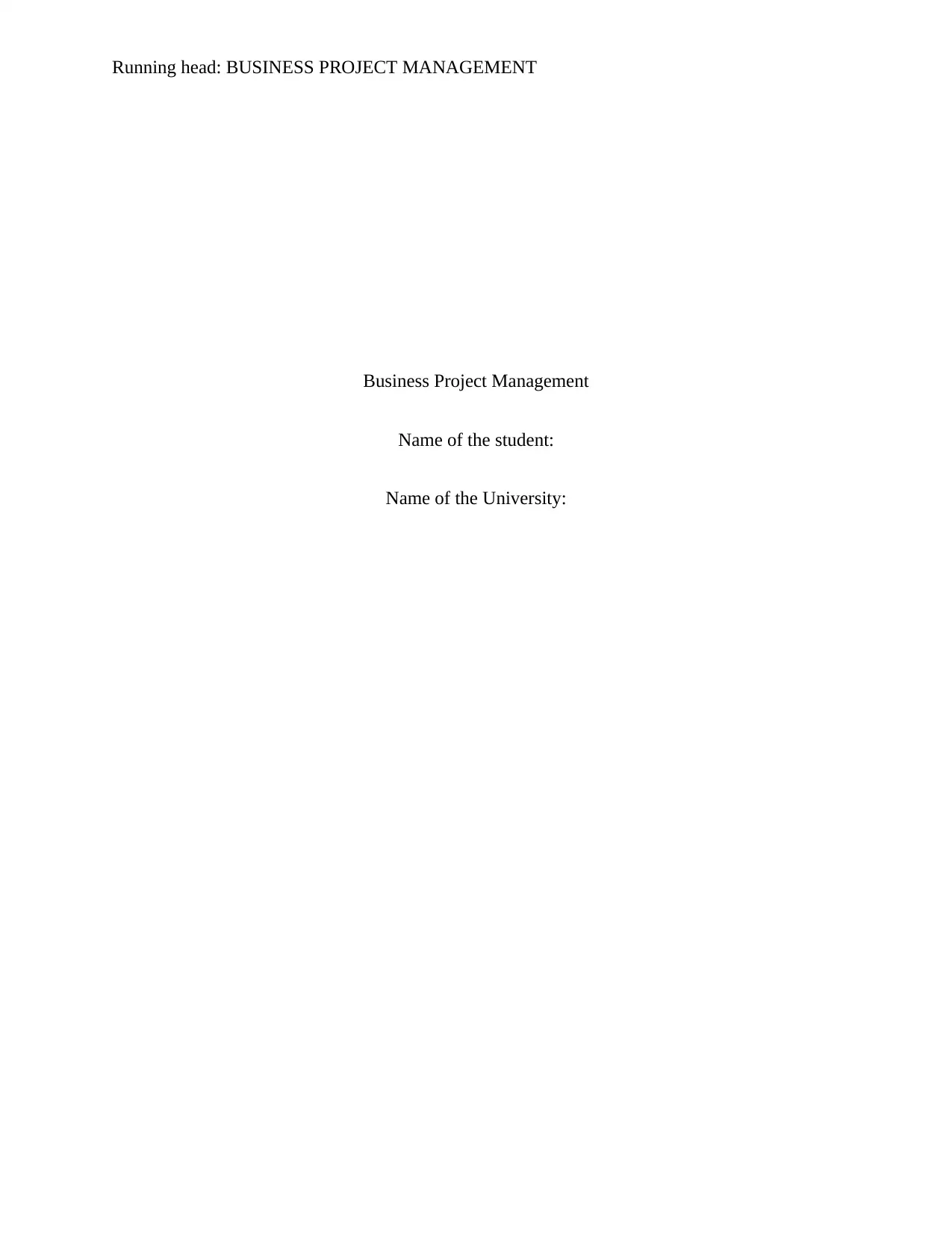
Running head: BUSINESS PROJECT MANAGEMENT
Business Project Management
Name of the student:
Name of the University:
Business Project Management
Name of the student:
Name of the University:
Paraphrase This Document
Need a fresh take? Get an instant paraphrase of this document with our AI Paraphraser
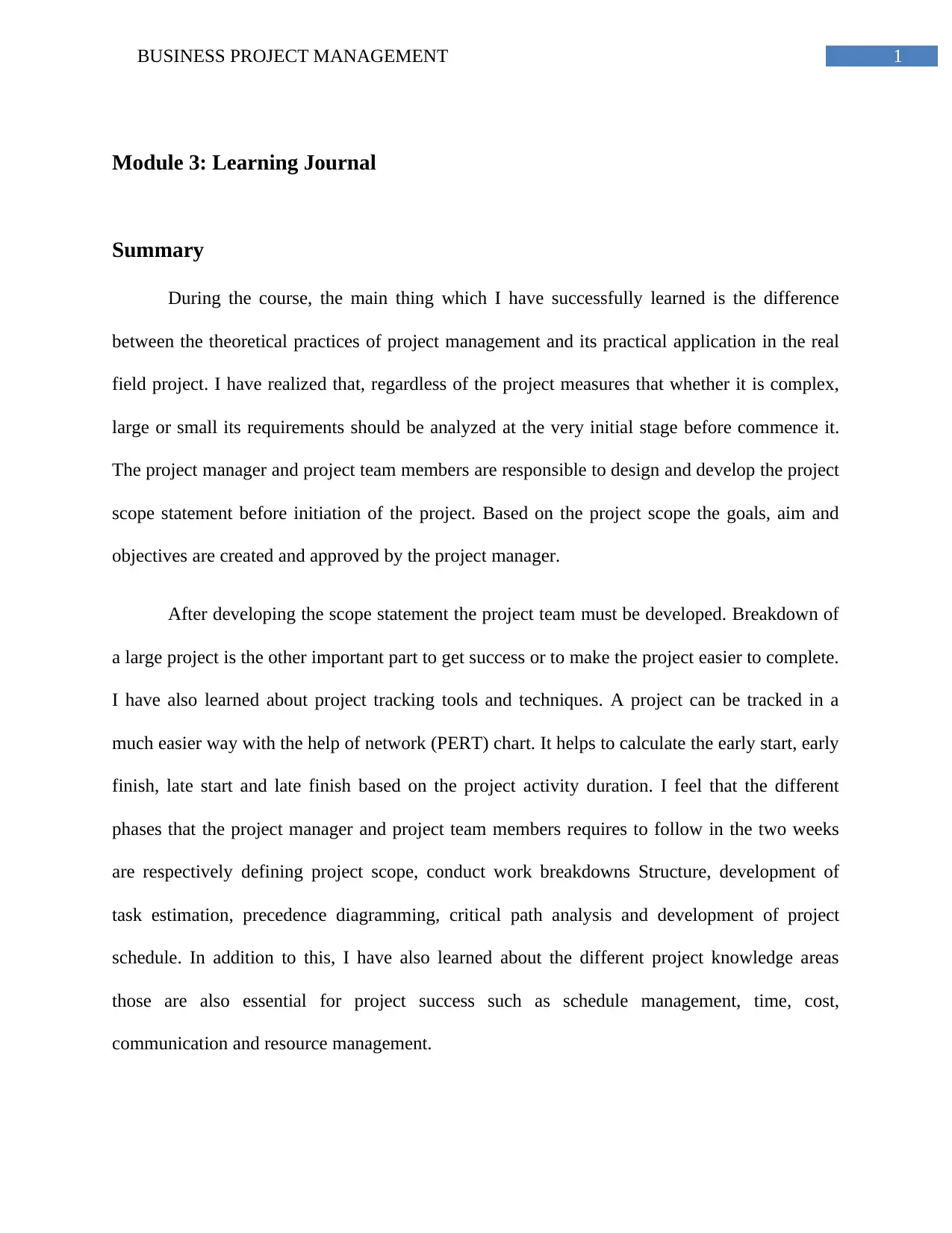
1BUSINESS PROJECT MANAGEMENT
Module 3: Learning Journal
Summary
During the course, the main thing which I have successfully learned is the difference
between the theoretical practices of project management and its practical application in the real
field project. I have realized that, regardless of the project measures that whether it is complex,
large or small its requirements should be analyzed at the very initial stage before commence it.
The project manager and project team members are responsible to design and develop the project
scope statement before initiation of the project. Based on the project scope the goals, aim and
objectives are created and approved by the project manager.
After developing the scope statement the project team must be developed. Breakdown of
a large project is the other important part to get success or to make the project easier to complete.
I have also learned about project tracking tools and techniques. A project can be tracked in a
much easier way with the help of network (PERT) chart. It helps to calculate the early start, early
finish, late start and late finish based on the project activity duration. I feel that the different
phases that the project manager and project team members requires to follow in the two weeks
are respectively defining project scope, conduct work breakdowns Structure, development of
task estimation, precedence diagramming, critical path analysis and development of project
schedule. In addition to this, I have also learned about the different project knowledge areas
those are also essential for project success such as schedule management, time, cost,
communication and resource management.
Module 3: Learning Journal
Summary
During the course, the main thing which I have successfully learned is the difference
between the theoretical practices of project management and its practical application in the real
field project. I have realized that, regardless of the project measures that whether it is complex,
large or small its requirements should be analyzed at the very initial stage before commence it.
The project manager and project team members are responsible to design and develop the project
scope statement before initiation of the project. Based on the project scope the goals, aim and
objectives are created and approved by the project manager.
After developing the scope statement the project team must be developed. Breakdown of
a large project is the other important part to get success or to make the project easier to complete.
I have also learned about project tracking tools and techniques. A project can be tracked in a
much easier way with the help of network (PERT) chart. It helps to calculate the early start, early
finish, late start and late finish based on the project activity duration. I feel that the different
phases that the project manager and project team members requires to follow in the two weeks
are respectively defining project scope, conduct work breakdowns Structure, development of
task estimation, precedence diagramming, critical path analysis and development of project
schedule. In addition to this, I have also learned about the different project knowledge areas
those are also essential for project success such as schedule management, time, cost,
communication and resource management.
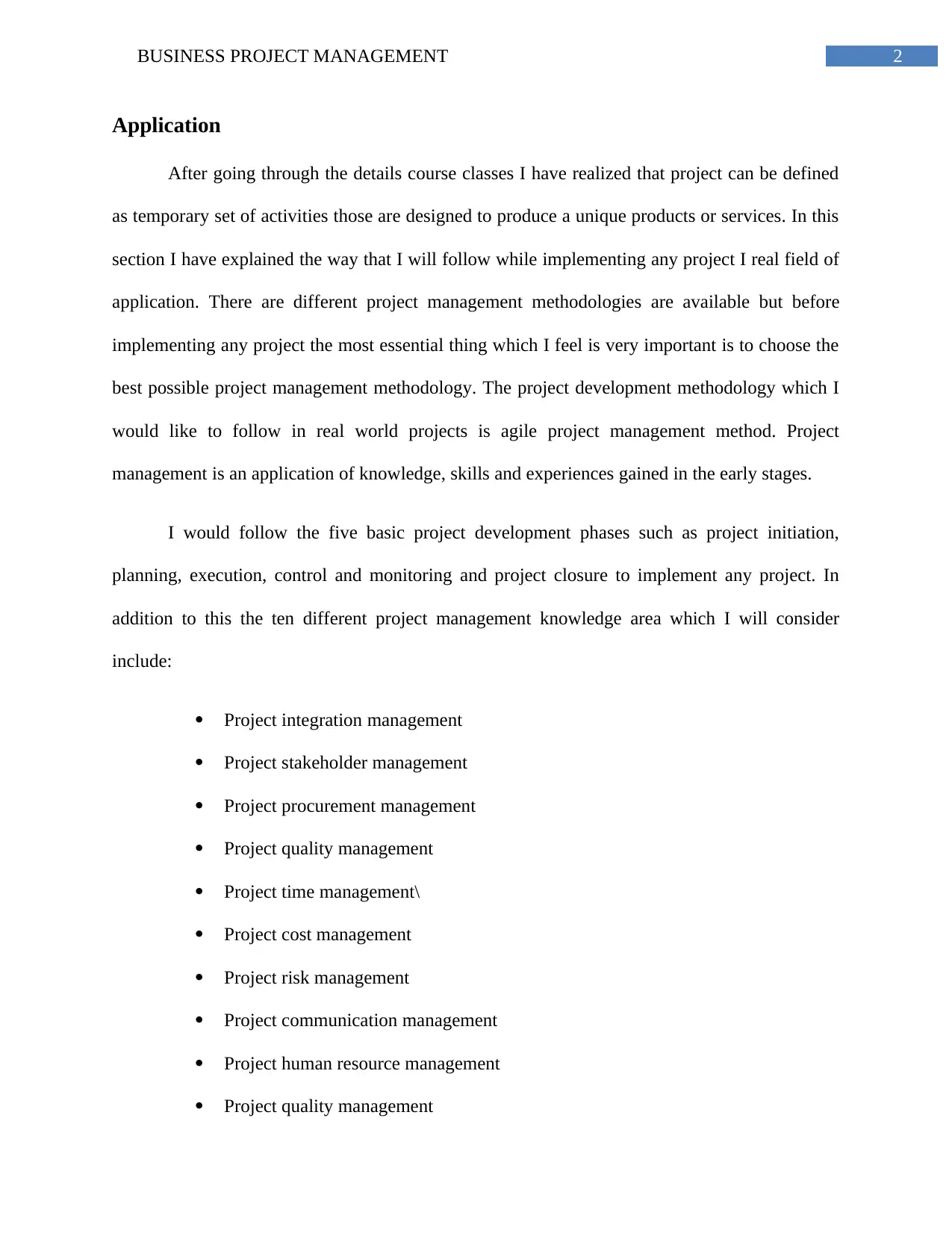
2BUSINESS PROJECT MANAGEMENT
Application
After going through the details course classes I have realized that project can be defined
as temporary set of activities those are designed to produce a unique products or services. In this
section I have explained the way that I will follow while implementing any project I real field of
application. There are different project management methodologies are available but before
implementing any project the most essential thing which I feel is very important is to choose the
best possible project management methodology. The project development methodology which I
would like to follow in real world projects is agile project management method. Project
management is an application of knowledge, skills and experiences gained in the early stages.
I would follow the five basic project development phases such as project initiation,
planning, execution, control and monitoring and project closure to implement any project. In
addition to this the ten different project management knowledge area which I will consider
include:
Project integration management
Project stakeholder management
Project procurement management
Project quality management
Project time management\
Project cost management
Project risk management
Project communication management
Project human resource management
Project quality management
Application
After going through the details course classes I have realized that project can be defined
as temporary set of activities those are designed to produce a unique products or services. In this
section I have explained the way that I will follow while implementing any project I real field of
application. There are different project management methodologies are available but before
implementing any project the most essential thing which I feel is very important is to choose the
best possible project management methodology. The project development methodology which I
would like to follow in real world projects is agile project management method. Project
management is an application of knowledge, skills and experiences gained in the early stages.
I would follow the five basic project development phases such as project initiation,
planning, execution, control and monitoring and project closure to implement any project. In
addition to this the ten different project management knowledge area which I will consider
include:
Project integration management
Project stakeholder management
Project procurement management
Project quality management
Project time management\
Project cost management
Project risk management
Project communication management
Project human resource management
Project quality management
⊘ This is a preview!⊘
Do you want full access?
Subscribe today to unlock all pages.

Trusted by 1+ million students worldwide
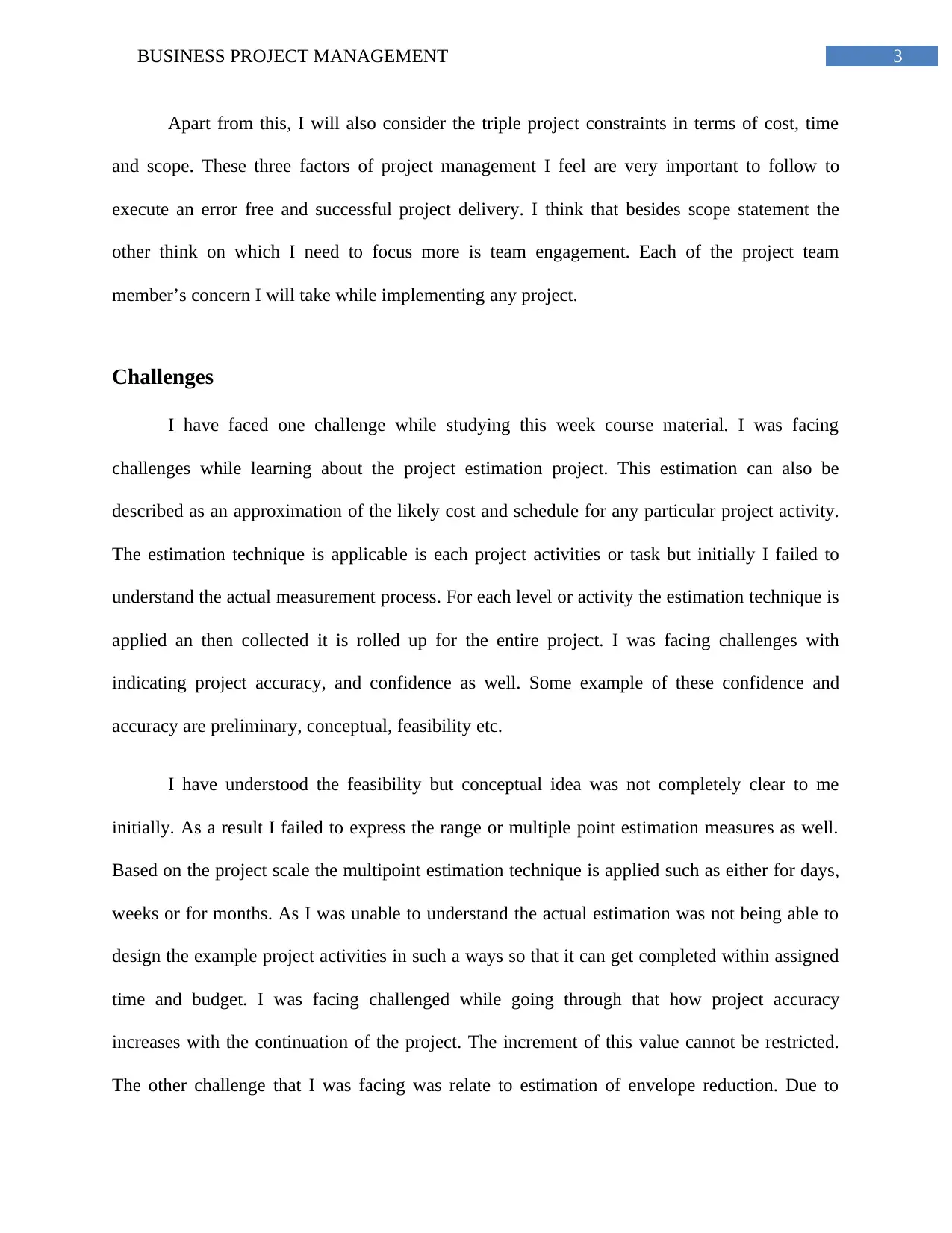
3BUSINESS PROJECT MANAGEMENT
Apart from this, I will also consider the triple project constraints in terms of cost, time
and scope. These three factors of project management I feel are very important to follow to
execute an error free and successful project delivery. I think that besides scope statement the
other think on which I need to focus more is team engagement. Each of the project team
member’s concern I will take while implementing any project.
Challenges
I have faced one challenge while studying this week course material. I was facing
challenges while learning about the project estimation project. This estimation can also be
described as an approximation of the likely cost and schedule for any particular project activity.
The estimation technique is applicable is each project activities or task but initially I failed to
understand the actual measurement process. For each level or activity the estimation technique is
applied an then collected it is rolled up for the entire project. I was facing challenges with
indicating project accuracy, and confidence as well. Some example of these confidence and
accuracy are preliminary, conceptual, feasibility etc.
I have understood the feasibility but conceptual idea was not completely clear to me
initially. As a result I failed to express the range or multiple point estimation measures as well.
Based on the project scale the multipoint estimation technique is applied such as either for days,
weeks or for months. As I was unable to understand the actual estimation was not being able to
design the example project activities in such a ways so that it can get completed within assigned
time and budget. I was facing challenged while going through that how project accuracy
increases with the continuation of the project. The increment of this value cannot be restricted.
The other challenge that I was facing was relate to estimation of envelope reduction. Due to
Apart from this, I will also consider the triple project constraints in terms of cost, time
and scope. These three factors of project management I feel are very important to follow to
execute an error free and successful project delivery. I think that besides scope statement the
other think on which I need to focus more is team engagement. Each of the project team
member’s concern I will take while implementing any project.
Challenges
I have faced one challenge while studying this week course material. I was facing
challenges while learning about the project estimation project. This estimation can also be
described as an approximation of the likely cost and schedule for any particular project activity.
The estimation technique is applicable is each project activities or task but initially I failed to
understand the actual measurement process. For each level or activity the estimation technique is
applied an then collected it is rolled up for the entire project. I was facing challenges with
indicating project accuracy, and confidence as well. Some example of these confidence and
accuracy are preliminary, conceptual, feasibility etc.
I have understood the feasibility but conceptual idea was not completely clear to me
initially. As a result I failed to express the range or multiple point estimation measures as well.
Based on the project scale the multipoint estimation technique is applied such as either for days,
weeks or for months. As I was unable to understand the actual estimation was not being able to
design the example project activities in such a ways so that it can get completed within assigned
time and budget. I was facing challenged while going through that how project accuracy
increases with the continuation of the project. The increment of this value cannot be restricted.
The other challenge that I was facing was relate to estimation of envelope reduction. Due to
Paraphrase This Document
Need a fresh take? Get an instant paraphrase of this document with our AI Paraphraser
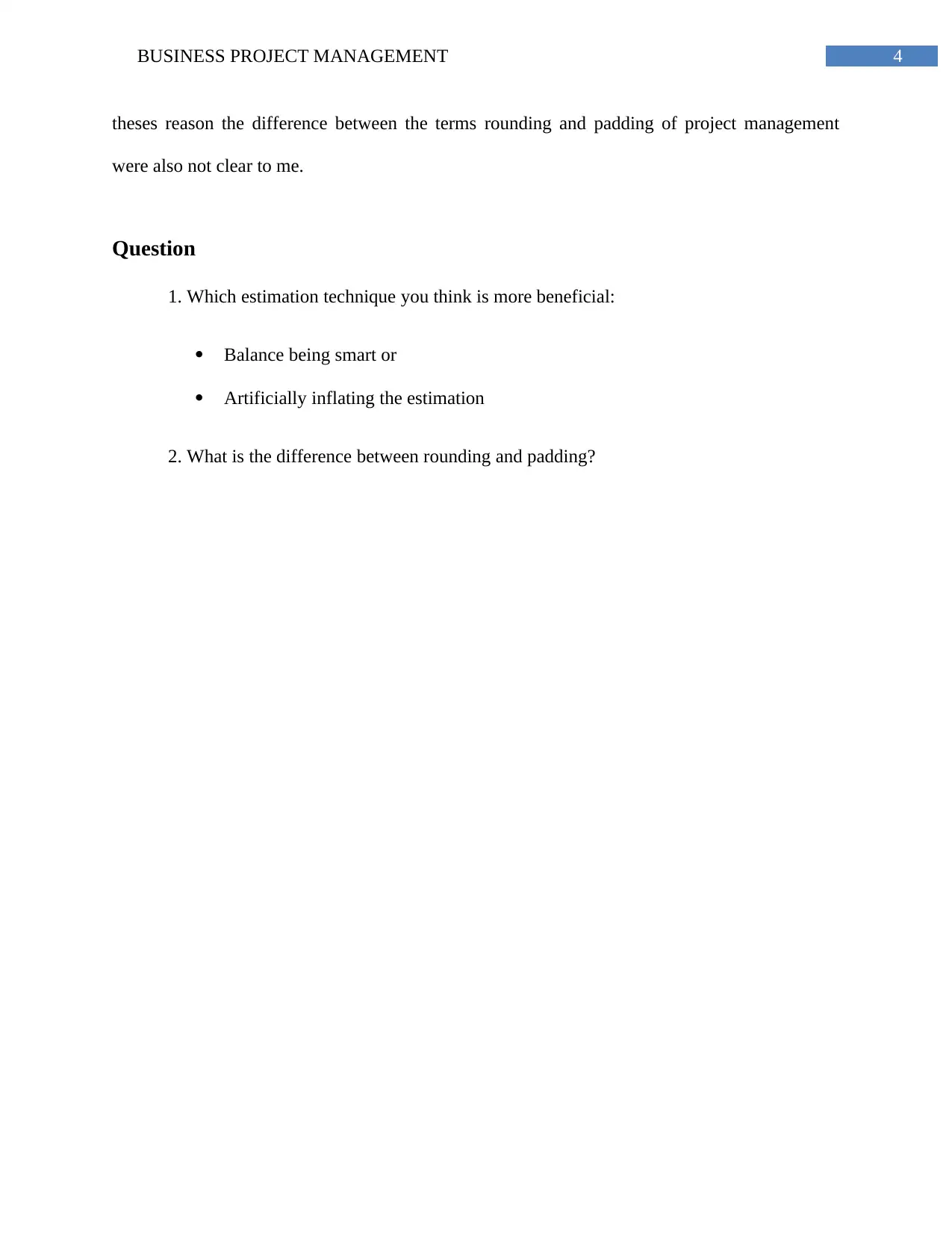
4BUSINESS PROJECT MANAGEMENT
theses reason the difference between the terms rounding and padding of project management
were also not clear to me.
Question
1. Which estimation technique you think is more beneficial:
Balance being smart or
Artificially inflating the estimation
2. What is the difference between rounding and padding?
theses reason the difference between the terms rounding and padding of project management
were also not clear to me.
Question
1. Which estimation technique you think is more beneficial:
Balance being smart or
Artificially inflating the estimation
2. What is the difference between rounding and padding?
1 out of 5
Related Documents
Your All-in-One AI-Powered Toolkit for Academic Success.
+13062052269
info@desklib.com
Available 24*7 on WhatsApp / Email
![[object Object]](/_next/static/media/star-bottom.7253800d.svg)
Unlock your academic potential
Copyright © 2020–2025 A2Z Services. All Rights Reserved. Developed and managed by ZUCOL.





